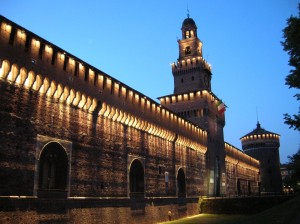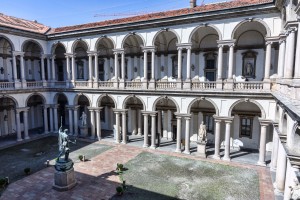My recommendations of places to visit in Milan..
Cimitero Monumentale
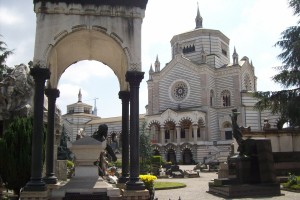 This cemetery is located north of the Centre of Milan and was designed by architect Carlo Maciachini. There are monumental tombs in the form of Greek temples, obelisks and buildings in Tuscan and Venetian style and rather bombastic monuments, some with a particular history such as that of Maria Maggi, in reality, Eva Perón.. It was a privilege to be buried here.
This cemetery is located north of the Centre of Milan and was designed by architect Carlo Maciachini. There are monumental tombs in the form of Greek temples, obelisks and buildings in Tuscan and Venetian style and rather bombastic monuments, some with a particular history such as that of Maria Maggi, in reality, Eva Perón.. It was a privilege to be buried here.
Special is the grave of one María Maggi. This was the grave of Eva Perón between 1957 and 1971 in the tomb. Eva was the wife of Argentine president Juan Perón in 1955, who was deposed in a military coup. Because the soldiers were afraid that the body of Eva would be a symbol of Peronism, they released her corpse to Milan where she was buried under a false name. Eva Perón is buried now in Argentina after many wanderings.
Piazza Cimitero Monumentale, Milan
Santa Maria delle Grazie
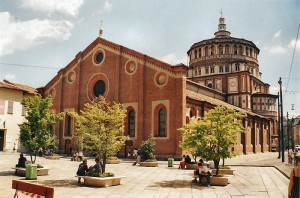 The Santa Maria delle Grazie (a former Dominican Monastery) is best known for one of the most famous works of art by Leonardo da Vinci: the last supper. That work of art in the dining room is often called a fresco, although it it not the officiaal painting. Da Vinci painted the last supper on a dry wall rather than on wet plaster. That technique did the painting no good, shortly after the completion (in 1498) continued to persistency. Then it got further damaged by failed restorations, pollution and – during the second world war – a bomb. The last restoration was completed in 1999.
The Santa Maria delle Grazie (a former Dominican Monastery) is best known for one of the most famous works of art by Leonardo da Vinci: the last supper. That work of art in the dining room is often called a fresco, although it it not the officiaal painting. Da Vinci painted the last supper on a dry wall rather than on wet plaster. That technique did the painting no good, shortly after the completion (in 1498) continued to persistency. Then it got further damaged by failed restorations, pollution and – during the second world war – a bomb. The last restoration was completed in 1999.
Piazza Santa Maria delle Grazie 2 (Corso Magenta), Milan
San Siro Stadion
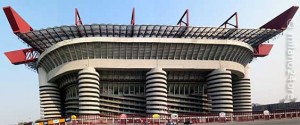 The football stadium of Milan can seat more than 85000 spectators and is home to both AC Milan and Inter Milan. During a tour, take a look behind the scenes and in the museum, you will discover that the Dutch Rijkaard, Gullit and Van Basten still stand on a pedestal. The stadium is officially named after Giuseppe Meazza, a soccer star from the 1930s. Meazza received his greatest successes at Inter and supporters of AC Milan don’t know what you are talking about if you ask about the Stadio Giuseppe Meazza. So most people know it as stadium San Siro.
The football stadium of Milan can seat more than 85000 spectators and is home to both AC Milan and Inter Milan. During a tour, take a look behind the scenes and in the museum, you will discover that the Dutch Rijkaard, Gullit and Van Basten still stand on a pedestal. The stadium is officially named after Giuseppe Meazza, a soccer star from the 1930s. Meazza received his greatest successes at Inter and supporters of AC Milan don’t know what you are talking about if you ask about the Stadio Giuseppe Meazza. So most people know it as stadium San Siro.
Via Piccolomini 5, Milan
Duomo Santa Maria Nascente
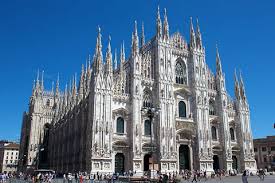 It cost centuries to finish the Milan Cathedral but now it is beautiful and finished. This Gothic church is the eyecatcher of the city with 135 marble ornamental turrets and over 2200 images. The rooftop terrace offers a beautiful view over Milan.
It cost centuries to finish the Milan Cathedral but now it is beautiful and finished. This Gothic church is the eyecatcher of the city with 135 marble ornamental turrets and over 2200 images. The rooftop terrace offers a beautiful view over Milan.
The oldest part of this large Gothic church is the apse, with three superb Lancet. On both sides of the altar you see beautifully crafted portals leading to the sacristy. The decorations of the arches of these portals date from the 14th century. Also the stained-glass Windows in the side aisles is not to be missed.
A visit to the roof terrace should not be forgoten. You can choose the stairs (500 steps) or the elevator. The rooftop terrace is decorated with marble pinnacles and you have a nice view over Milan, at least most of the time. Sometimes the view is obstructed by the air pollution above Milan.
Piazza del Duomo 14, Milan
Teatro alla Scala
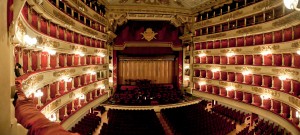 Even if you don’t like Opera a visit to La Scala is more than worth it. The Interior of the building is more like a cathedral than a concert hall. It was built on the site of a church, Santa Maria delle Scala, between 1775 and 1778. Verdi established here his fame as well as Maria Callas. It is not easy to get hold of a ticket for a show at the most famous opera house in the world. If that fails, you can always visit the adjacent museum with a fine collection of musical instruments, posters and costumes.
Even if you don’t like Opera a visit to La Scala is more than worth it. The Interior of the building is more like a cathedral than a concert hall. It was built on the site of a church, Santa Maria delle Scala, between 1775 and 1778. Verdi established here his fame as well as Maria Callas. It is not easy to get hold of a ticket for a show at the most famous opera house in the world. If that fails, you can always visit the adjacent museum with a fine collection of musical instruments, posters and costumes.
Piazza della Scala 1, Milan
Museo Poldi-Pezzoli
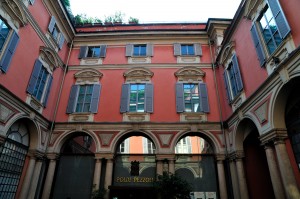 This museum in Milan has a collection based on the private collection of Gian Giacomo Poldi-Pezzoli out halfway through the 19th century began collecting art. At first there where only paintings and sculptures. After being in other European museums Poldi-Pezzoli also had seen jewelry, carpets, glass and porcelain and began with the collection thereof, mainly from the renaissance and 18th century Venetian art.
This museum in Milan has a collection based on the private collection of Gian Giacomo Poldi-Pezzoli out halfway through the 19th century began collecting art. At first there where only paintings and sculptures. After being in other European museums Poldi-Pezzoli also had seen jewelry, carpets, glass and porcelain and began with the collection thereof, mainly from the renaissance and 18th century Venetian art.
Via Manzoni 12
Museo Nazionale della Scienza e della Tecnica
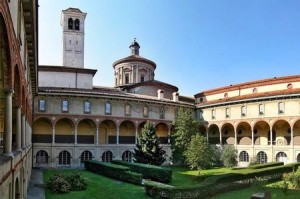 The National Museum of science and technology in Milan is one of the most important museums in the world in this area. The development of the steam engine, the invention of the radio by Marconi, beautiful old locomotives, old globes with the routes of explorers and many more can be seen in this museum.
The National Museum of science and technology in Milan is one of the most important museums in the world in this area. The development of the steam engine, the invention of the radio by Marconi, beautiful old locomotives, old globes with the routes of explorers and many more can be seen in this museum.
Via S. Vittore 21, Milan
Castello Sforzesco
Pinacoteca di Brera
This museum is located in the artists ‘ quarter of Milan, Brera, and has one of the most important and most fascinating collections of Italian artists, among whom masters as Rafael and Caravaggio. The museum is housed in an impressive baroque palace from the 17th century and has forty rooms.
Via Brera 28, Milan

